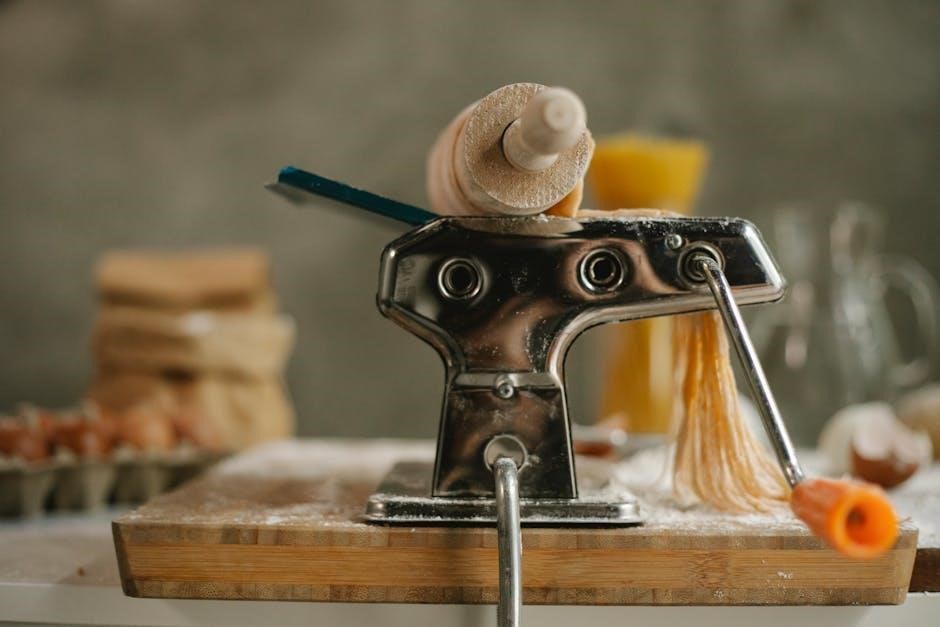
Manual tile cutters are simple, cost-effective tools for cutting ceramic, porcelain, and other soft tiles. They offer precise, dust-free cuts and are ideal for small DIY projects.
Overview of Manual Tile Cutters
A manual tile cutter is a portable, handheld tool designed to make straight cuts in ceramic, porcelain, and other soft tiles. It operates by scoring the tile with a sharp wheel and then snapping it along the scored line. These cutters are lightweight, easy to use, and require no electricity, making them ideal for small to medium-sized projects. They typically feature a sturdy base plate with a guide line to ensure accurate cuts. Manual tile cutters are available in various sizes to accommodate different tile dimensions and thicknesses, making them versatile for DIY enthusiasts and professionals alike. They are particularly useful for projects requiring precise, dust-free cuts without the need for heavy machinery.
Advantages of Using a Manual Tile Cutter
The manual tile cutter offers several advantages, making it a popular choice for DIY projects and small renovations; It is cost-effective and requires no electricity, making it accessible for anyone. The tool is lightweight and portable, allowing users to work anywhere without being tied to a power source. It produces minimal dust, keeping the workspace clean and organized; Manual tile cutters are easy to use, requiring only basic technique to achieve precise, straight cuts. They are ideal for softer materials like ceramic and porcelain, providing a clean finish with minimal effort. Additionally, they are low maintenance and durable, making them a practical investment for both professionals and homeowners.

How to Use a Manual Tile Cutter
Using a manual tile cutter involves marking the tile, scoring it with the wheel, and snapping it cleanly. It’s ideal for straight cuts on ceramic or porcelain tiles.
Step 1: Measuring and Marking the Tile
Accurate measurement is crucial for precise cuts. Use a measuring tape to determine where you want to cut the tile. Mark the cutting line with a felt-tip pen, ensuring it’s visible but easy to wipe off after cutting. Position the tile in the cutter, aligning one edge tightly against the end stop. Adjust the tile so your marked line aligns with the guide on the cutter’s base plate. Double-check the alignment to avoid mistakes. If your cutter allows, adjust the scoring wheel height to match the tile’s thickness and tighten it securely. This step ensures a clean, accurate cut. Always test the pen on a spare tile first to confirm it wipes off easily.
- Use a straight edge for precise marking.
- Ensure the tile is securely positioned before scoring.
Step 2: Scoring the Tile
Once the tile is properly aligned, pull the cutter’s handle back and position the scoring wheel over your marked line. Hold the tile firmly in place to prevent movement. With a smooth, steady motion, push the handle forward to apply consistent pressure, moving the scoring wheel along the marked line. Ensure the wheel aligns precisely with the guide to maintain accuracy. Apply enough force to create a clear, visible score line but avoid applying too much pressure, which could crack the tile. After scoring, inspect the line to confirm it’s evenly cut. If necessary, repeat the process to deepen the score. For best results, practice this step on spare tiles to refine your technique.
- Use steady, consistent pressure to score the tile.
- Ensure the scoring wheel aligns with your marked line.
- Check the score line before proceeding to the next step.
Step 3: Snapping the Tile
With the score line in place, position the breaker (snapper) directly over the line. Gently but firmly push down on the handle until the tile snaps along the scored line. For larger or thicker tiles, apply slightly more pressure. If the tile doesn’t snap cleanly, repeat the process, ensuring the breaker is aligned correctly. For small or irregular cuts, use tile nippers or a wet saw for precision. After snapping, smooth any rough edges with a tile stone or fine sandpaper. This step requires patience and careful alignment to achieve a clean, professional result.
- Align the breaker with the score line.
- Apply firm, controlled pressure to snap the tile.
- Use additional tools for small or irregular cuts.

Choosing the Right Manual Tile Cutter
Choosing the right manual tile cutter involves considering tile material, thickness, and project size. Opt for a cutter that suits your tile type and offers versatility for various materials.

Considering Tile Material and Thickness
Manual tile cutters are best suited for softer materials like ceramic, porcelain, and extruded tiles. For harder materials such as natural stone or granite, electric cutters are often more effective. When selecting a manual cutter, ensure it can handle the thickness of your tiles, as most models accommodate tiles up to 15mm thick. Larger cutters may offer greater versatility for thicker tiles. Always check the manufacturer’s specifications to confirm compatibility with your tile type and size. This ensures precise, clean cuts and extends the tool’s lifespan. For very small or intricate cuts, additional tools like tile nippers may be necessary. Proper material and thickness matching guarantees optimal performance.
Selecting the Correct Cutter Size
Choosing the right size of a manual tile cutter is essential for effective and efficient tile cutting. The cutter size should primarily be determined by the dimensions of the tiles you are working with. For larger tiles, such as those measuring 600mm, a bigger cutter is necessary to accommodate their size, ensuring precise cuts. Conversely, standard-sized tiles (e.g., 150mm x 150mm or 100mm x 200mm) typically require a smaller cutter. It’s important to consider both the length and width of the tiles, as well as their thickness, as cutters have specific limitations on the thickness they can handle, usually provided by the manufacturer. For projects requiring multiple or complex cuts, a larger cutter offers greater flexibility and accuracy. Additionally, if you plan to use the cutter for future projects or larger-scale tiling, investing in a more versatile model is advisable. Portability and storage are also factors; larger cutters may be less convenient to transport and store. Evaluating your budget and the cutter’s build quality is crucial, as a larger cutter may be more durable but also more expensive. Availability of replacement parts and your familiarity with the tool should also influence your decision. Starting with a standard size is recommended if you’re new to using manual tile cutters, as larger models can be more complex to operate. Ultimately, selecting the correct cutter size involves balancing tile dimensions, project requirements, practicality, and personal expertise to achieve optimal results.

Safety Precautions When Using a Manual Tile Cutter
Always wear protective gear, including safety goggles and gloves, to prevent injury from flying debris or sharp edges. Ensure a stable workspace and handle tools with care.
Essential Safety Tips
When using a manual tile cutter, always wear safety goggles and gloves to protect yourself from sharp edges and flying debris. Ensure the cutter is placed on a stable, flat surface to prevent accidents. Keep your hands and fingers away from the scoring wheel and breaker bar during operation. Maintain a firm grip on the tile to avoid slippage. Avoid overreaching or applying excessive force, as this can lead to loss of control. Regularly inspect the cutter for wear and tear, and replace worn-out parts promptly. Store the tool in a secure location out of reach of children. Always handle sharp tile edges with care, and use a tile stone or sandpaper to smooth rough cuts. By following these guidelines, you can ensure a safe and efficient cutting process.
Protective Gear Recommendations
When using a manual tile cutter, it is crucial to wear appropriate protective gear to minimize risks. Always wear safety goggles to protect your eyes from debris and dust. Heavy-duty gloves are essential to prevent cuts and improve grip while handling sharp tile edges. A dust mask is recommended to avoid inhaling dust particles during cutting. Wearing steel-toe shoes and keeping long hair tied back can further enhance safety. Ensure all protective gear fits properly and is in good condition. By prioritizing these precautions, you can safeguard yourself against potential hazards and maintain a secure working environment while using a manual tile cutter.
Maintenance and Care of Your Manual Tile Cutter
Regular cleaning, proper storage, and lubricating moving parts ensure optimal performance. Check and replace worn components to maintain accuracy and extend the tool’s lifespan.

Cleaning and Storing the Cutter
Regular cleaning is essential to maintain the performance of your manual tile cutter. Use a soft cloth and mild soap to wipe down the base, scoring wheel, and handles. Avoid harsh chemicals, as they may damage the tool. After cleaning, dry the cutter thoroughly to prevent rust. Store the cutter in a dry, protected area to avoid dust accumulation. For added protection, cover the cutter when not in use. Proper storage ensures the cutter remains in good condition for future projects. Additionally, periodically lubricate moving parts to keep them functioning smoothly. Regular maintenance extends the lifespan of your manual tile cutter and ensures precise cuts every time.
Replacing or Sharpening the Scoring Wheel
The scoring wheel of a manual tile cutter can become dull over time, affecting cut quality. To maintain performance, regularly inspect the wheel for wear. If it appears worn or cuts become inconsistent, sharpen or replace it. Sharpening can be done using a diamond stone or a specialized sharpening tool. For replacement, purchase a compatible wheel from the manufacturer or a hardware store. To replace, loosen the retaining bolts with an Allen wrench, remove the old wheel, and install the new one, ensuring proper alignment. Always refer to the cutter’s manual for specific instructions. A sharp scoring wheel ensures clean, precise cuts and extends the cutter’s lifespan.

Tips for Achieving Clean Cuts
Use the correct scoring technique and apply steady, consistent pressure. Ensure the tile is securely held and align the scoring wheel precisely with your mark for precise cuts.
Using the Correct Scoring Technique
To achieve clean cuts, ensure the tile is positioned with the glazed side facing up and held firmly against the end stop. Align the scoring wheel precisely with your marked line and apply steady, consistent pressure. Gently push the scoring wheel across the tile in one smooth motion, maintaining control throughout. Avoid applying too much pressure, as this could cause uneven scoring. After scoring, use the snapping mechanism to break the tile along the scored line. For smoother edges, use a tile stone to rub down any rough spots. Proper technique ensures precise cuts and minimizes waste, making your tiling projects more efficient and professional-looking.
Handling Different Tile Types
When using a manual tile cutter, it’s essential to adjust your technique based on the type of tile. For ceramic and porcelain tiles, which are softer, a steady scoring motion ensures a clean break. Use a tile stone to smooth any rough edges. For thicker or harder tiles, like natural stone, a larger cutter or a wet saw may be necessary. Glass tiles require a specialized cutter to prevent shattering. Always test your cutter on a spare tile to ensure compatibility. By adapting your method to the tile material, you can achieve precise, professional-looking cuts every time.